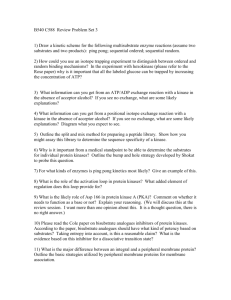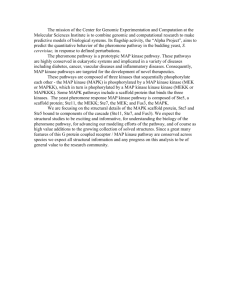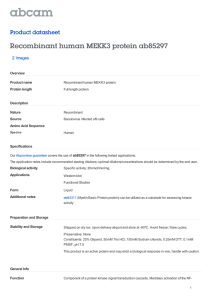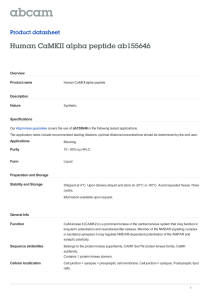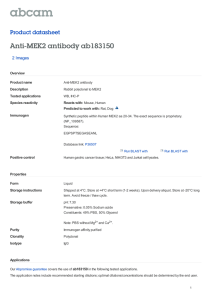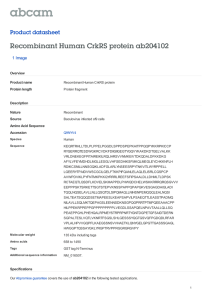Current Research Journal of Biological Sciences 2(1): 59-71, 2010 ISSN: 2041-0778
advertisement
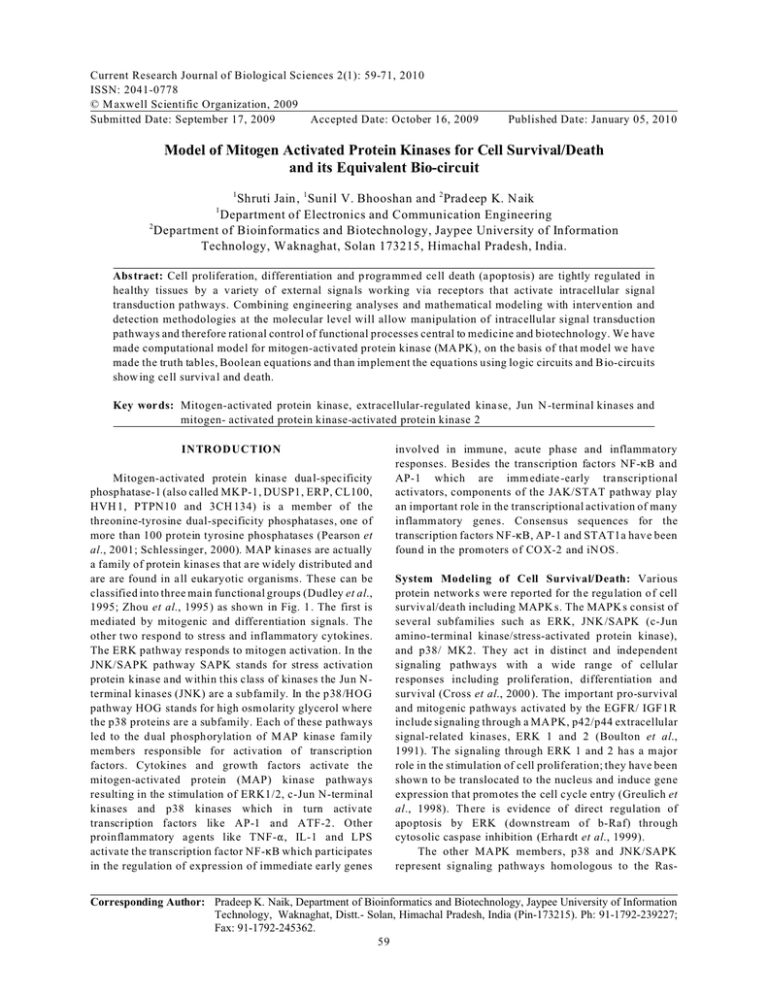
Current Research Journal of Biological Sciences 2(1): 59-71, 2010 ISSN: 2041-0778 © M axwell Scientific Organization, 2009 Submitted Date: September 17, 2009 Accepted Date: October 16, 2009 Published Date: January 05, 2010 Model of Mitogen Activated Protein Kinases for Cell Survival/Death and its Equivalent Bio-circuit 1 Shruti Jain, 1 Sunil V. Bhooshan and 2 Prad eep K. N aik Department of Electronics and Communication Engineering 2 Department of Bioinformatics and Biotechnology, Jaypee University of Information Technology, W aknaghat, Solan 173215, Himachal Pradesh, India. 1 Abstract: Cell proliferation, differentiation and p rogramm ed cell death (a poptosis) are tightly reg ulated in healthy tissues by a variety of external signa ls wo rking via receptors that activate intracellular signal transduction pathways. Combining engineering analyses and mathematical modeling with intervention and detection methodologies at the molecular level will allow manipulation of intracellular signal transduction pathways and therefore rational control of functional processes central to medicine and biotechnology. We have made computational model for mitogen-activated protein kinase (MA PK), on the basis of that model we have made the truth tables, Boolean equations and than implement the equa tions using logic circuits and B io-circuits show ing cell surviva l and death. Key words: Mitogen-activated protein kinase, extracellular-regulated kina se, Jun N -terminal kinases and mitogen- activated protein kinase-activated protein kinase 2 INTRODUCTION Mitogen-activated protein kinase dua l-specificity phosphatase-1 (also called MK P-1, DUSP1, ER P, CL100, HVH 1, PTPN10 and 3CH 134) is a member of the threonine-tyrosine dual-specificity phosphatases, one of more than 100 protein tyrosine phosphatases (Pearson et al., 2001; Schlessinger, 2000). MAP kinases are actually a family of protein kinases that are widely distributed and are are found in all eukaryotic organisms. These can be classified into three main functional groups (Dudley et al., 1995; Zhou et al., 1995 ) as sho wn in Fig. 1. The first is mediated by mitogenic and differentiation signals. The other two respond to stress and inflammatory cytokines. The ERK pathway responds to mitogen activation. In the JNK/SAPK pathway SAPK stands for stress activation protein kinase and within this class of kinases the Jun Nterminal kinases (JNK) are a subfamily. In the p38/HOG pathway HOG stands for high osm olarity glycerol where the p38 proteins are a subfamily. Each of these pathways led to the dual ph osph orylation of M AP kinase family mem bers responsible for activation of transcription factors. Cytokines and growth factors activate the mitogen-activated protein (MAP) kinase pathways resulting in the stimulation of ERK1/2, c-Jun N-terminal kinases and p38 kinases which in turn activate transcription factors like AP-1 and ATF-2. Other proinflammatory agents like TNF-", IL-1 and LPS activate the transcription factor NF-6B which participates in the regulation of expression of immediate early genes involved in immune, acute phase and inflamm atory responses. Besides the transcription factors NF-6B and AP-1 which are imm ediate -early tra nscrip tional activators, components of the JAK/STAT pathway play an important role in the transcriptional activation of many inflammatory genes. Consensus sequences for the transcription factors NF-6B, AP-1 and STAT1a have been found in the prom oters of CO X-2 and iN OS . System Modeling of Cell Survival/Death: Various protein network s we re repo rted for the regu lation of cell survival/death including MAPK s. The MAPK s consist of several subfamilies such as ERK, JNK /SAPK (c-Jun amino-terminal kinase/stress-activated p rotein kinase), and p38/ MK2. They act in distinct and independent signaling pathways with a wide range of cellular responses including proliferation, differentiation and survival (Cross et al., 2000 ). The important pro-survival and mitogenic pathways activated by the EGFR/ IGF1R include signaling through a MA PK, p42/p44 extracellular signal-related kinases, ERK 1 and 2 (Boulton et al., 1991). The signaling through ERK 1 and 2 has a major role in the stimulation of cell proliferation; they have been shown to be translocated to the nucleus and induce gene expression that prom otes the cell cycle entry (Greulich et al., 1998). Th ere is evidence of direct regulation of apoptosis by ERK (downstream of b-Raf) through cytosolic caspase inhibition (Erhardt et al., 1999). The other MAPK members, p38 and JNK/SAPK represent signaling pathways hom ologous to the Ras- Corresponding Author: Pradeep K. Naik, Department of Bioinformatics and Biotechnology, Jaypee University of Information Technology, Waknaghat, Distt.- Solan, Himachal Pradesh, India (Pin-173215). Ph: 91-1792-239227; Fax: 91-1792-245362. 59 Curr. Res. J. Biol. Sci., 2(1): 59-71, 2010 Fig. 1: Three main functional groups of MAP kinases MA PK pathways, which are involved in the regulation of cellular responses to stress (Kyriakis et al., 1996). These pathways, in contrast, are not activated primarily by mitogens, but instead by various kinds of cellular stress and inflamm atory cytokin es, and result in apop tosis (Kyriakis et al., 1996 ). translation of selec tive mRN As. ERK plays a ro le in initiating protein synthesis by phosphorylating Mnk 1 which results in the removal of secondary structure at the initiation site for protein synthesis. Mnk1 is also the target for some viruses when hijacking ce llular protein synthesis. For example, adenovirus protein p100 binds eIFG and displac es M nk1 so that it is no long er able to activate eIF-4E. A s a result, cellular mRNA remains untranslated while viral mRNA is unaffected and, as a result, the cell switches to the manufacture of viral protein s. The RAS/ER K pathway: Growth factor stim ulation activates various signaling pathways that result in the induction of a variety of genes involved in the regulation of cell proliferation, cell differentiation an d cell cy cle progression. The ERK MA P kinase cascade is one of the central pathw ays in growth factor signal transductions. In response to growth factor stimulation, classical MAP kinase kinase M EK beco mes activated, and then the activated ME K ph osphorylates and activates classical MA P kinase ERK. EGF/IRS activates the ERK pathway through the binding of Grb2 or Shc to phosphorylated ErbB receptors, which in turn results in the recruitment of the son of sevenless (SOS) to the activated receptor dimmer SOS then activates RA S lead ing to the activation of RAF 1 (Hallberg et al., 1994; Eyers et al., 1998). RAF1 subsequently phosphorylates MEK1 and MEK 2 which activate respectively ERK1 and ER k2. The MA P kinases (MA PKs) are serine/ threonine protein kinases e.g. ER K1/2 (extracellular signal-related kinase 1/2), which are activated by MAP/ERK kinases (M EK s), wh ich in turn is activated by MEK kinase (ME KK ), such as R af. This pathway results in cell proliferation and in the increased transcription of Bcl2 family members and inhibitors of apoptosis proteins (IAPs), thereby promoting cell survival. Mitogenic sigalling increases the rate of JNK pathway: The second most widely studied MAP kinase cascade is the JNK /SAP K (c-Jun NH 2 -terminal kinase/stress activated protein kinase). The c-Jun kinase (JNK) is activated when cells are exposed to ultraviolet (UV) radiation , heat sh ock, or inflammatory cytokines. How ever, the functional consequence of JNK activation in UV -irradiated cells has not been established. It is shown here that JNK is required for UV-induced apoptosis in primary murine embryonic fibroblasts. Fibroblasts with simultaneous targeted disruptions of all the functional Jnk gene s were protected against UVstimulated apoptosis. The absence of JNK caused a defect in the mitochondrial death signaling pathway, including the failure to release cytochrome c. These data indicate that mitochondria are influenced by proapoptotic signal transduction through the JNK pathway. The activation of these MA P kinases is mediated by Rac and cdc42, two small G-proteins. The activated cdc42 binds to PAK65 protein kinase and activates it. The activated PAK65 can activate MEKK, which in turn phosphorylates SEK/JNKK 60 Curr. Res. J. Biol. Sci., 2(1): 59-71, 2010 and activates it. The active SEK/JNKK phosphorylates JNK/SAPK (at the TPY motif) that in turn binds to the Nterminal region of c-Jun and phosphorylates it as shown in Eq. 1. p38 pathway: The p38 kinase is the m ost w ellcharacterized mem ber of the M AP kinase family. It is activated in response to inflammatory cytokines, endotoxins, and osmotic stress. It shares about 50% homology with the ERK s. The upsteam steps in its activation of this cascade are not well defined. Ho wev er, downstream activation of p38 occu rs follow ing its phosphorylation (at theTGY m otif) by MKK 3, a dual specificity kinase. Following its activation, p38 translocates to the nucleus and phosphoryates ATF-2. Another known target of p38 is MAPK2 that is involved in the phosphorylation and activation of heat-shock protein s. Although different MA P kinase cascades show high degree of specificity and functional separation, some degree of cross-talk is observed between different pathways. For example , JNKK, an activator of JNK/SAPK, is reported to activate p38, whereas MKK3 activates only p38 and not JNK/SAPK . MEKK 1 that stimulates SEK/JNKK 1 in the JNK/SAPK cascade has only a trivial effect on p38 ac tivation. In the upstream signaling, SOS stimulates only the ERK pathways without affecting either JNK or p38 cascade. Another important observation is that if mammalian cells are trea ted w ith mitogenic agents; ERKs are significantly activated whereas JNK/SAPK are not affected. C onversely, cells exposed to stress cells activate JNK/SAPK pathway without altering the activity of ERK s. At the transcription level, ATF-2 is phosphorylated and activated by all three M A P kinases, whereas c-Jun and Elk-1 are phosphorylated by ERKs and JNK /SAPK , yet all these pathways result in transcriptional activity that is unique for a particular external stress. (1) (2) RESULTS AND DISCUSSION Experimental findings: The experimental findings of cell survival or cell death w ith respe ct to cytokine treatme nts was conducted by G audet et al. (2005) and Janes et al. (2005). Each treatment consisted of a combination of TNF and either EGF or insulin Cells respond to TNF, EGF, and insulin in a do se-dependent manner and all three cytokines were therefore examined at sub saturating concentrations, designed to mimic physiological conditions, and at saturating concentrations, at which essen tially all receptors were ligand-bound. All togethe r, ERK, JNK and M K2 signals were examined. Kinases such as Akt and ER K w ere maximally active 5-15 min after cytokine addition whereas caspase cleavage was evident only after 4 h time shown in Table 1. Based on the heat map (Fig. 3) from Gaudet et al. (2005), the respective time dependent signals of ERK pathway in cells have been eludicated (Fig. 3). For each treatment, the average signal intensities were normalized to the maximal value obtained for that signal (1: green; 0: red) and are plotted for the 13 time points. Fig. 4 and 5a to j shows the heat map and corresponding graph of timedependent signals for JNK and MK 2 respectively using TNF/ EGF/ Insulin combination of 0/0/0 ng/ml with (0, 5, 15, 30, 60, 90, 120 m in) and then (4, 8, 12 , 16, 20, 24 h). (1) (2) (two small G proteins) 61 Curr. Res. J. Biol. Sci., 2(1): 59-71, 2010 Fig. 2: Block diagram of cell survival and cell death Table 1: Combination of ten cytokine treatments used in the experimental study (Gaudet et al. 2005) (a) (b) (c) (d) (e) (f) TN F(n g/m l) 5 100 5 100 EG F(n g/m l) 100 110 0 Insu lin(ng /ml) - Compendium Model: On the basis of block diagram (Fig. 2) we have mad e truth tab les of ev ery po ssible path culminate in cell death/ surv ival of individu al inputs i.e. TNF, EGF and Insulin. Than we realize the truth tables by Karnaugh Map (K -Map) an d get the expression for each input and its individual possible paths. With the help of Boolean equations we have implemented circuits using Log ic gates. Logic gates are the basic b uilding block s in electronic circuits that perform logical operations. These have input and output signals in the form of 0’s and 1’s; ‘0’ signifies the absence of signal while ‘1’ sign ifies its presence. Similar to the electronic logic gates, cellular com ponents can serve as logic gates. A typical biological circuit consists of (i) a coding reg ion, (ii) its promo ter, (iii) RN A polymerase and the (iv) regulatory proteins with their v) DNA binding elements, and vi) small signaling molecules that interact with the regulatory proteins (Weiss et al., 2002; 2003). Th ere are three steps in a simple gate: (i) Translation o f the input mR NA signal, (ii) cooperative binding of the protein (repressor) to the D NA (operator) and (iii) regulated gene expre ssion to generate the output (g) 500 (h) 0.2 1 (i) 5 5 (j) 100 500 signal. Therefore, the output signal is influenced by the amino acid synthesis occurring in the cell, the affinities of the ribosome binding sites on the mRN A and its stability. Other factors like dimerization of the repressor proteins and the affinities to their respective operators also play a role in determining the amount of the output signal. Messenger RNA or their translation products can serve as input and output signals to the logic gates formed by genes with which these gene products interact. The concentration of the gene product determ ines the strength of the sign al. High concentration indicates the presence of signal (=1) i.e. survival whereas low concentration indicates its absence (=0) i.e., death. The NOT Gate: The NOT gate is the simplest biochemical circuit. The gate has a single input signal. The NOT gate ‘inverts’ the input signal, hence known as the inverter gate shown in Fig. 6. The enzyme RNA polymerase binds to DN A elements called prom oters to carry out transcription (the conversion of the information in DN A to an intermed iate, mR NA ). The gate is used to determ ine the intracellular state o f the cell. 62 Curr. Res. J. Biol. Sci., 2(1): 59-71, 2010 (a) (d) (b) (e) (c) (f) 63 Curr. Res. J. Biol. Sci., 2(1): 59-71, 2010 (g) (i) (h) (j) Fig. 3: Heat map and corresponding graph of time-dependent signals in cells treated with 10 cytokine combinations of ERK. For each treatment, the average signal intensities were normalized to the maximal value obtained for that signal and are plotted for the 13 time points The AND Gate: The AND gate has two input signals and only when both the signals are present, an output signal is generated shown in Fig. 7. The poly mera se intrinsically has low affinity for promoters, hence there is no transcription. The activator and inducer together result in turning on a gene. The gate can be used for cell-ce ll communication. Biocomputing, as the name suggests, is computation performed using biomolecules such as DN A and proteins. A biological process such as glycolysis or bioluminescence can be viewed as a genetic regulatory circuit. A genetic regulatory circuit is a complex set of biochemical reactions that regulates the behavior and function of genes, operons, DNA , RNA and proteins. The NOT gate is built using two promoter/repressor pairs. The inducer input is applied to the first prom oter/repressor pair (P1/R1). The output protein produced by the first repressor/promoter pair acts as the repressor (R2) to the second promoter (P2). Hence, whenever the inducer input is introduced, the second prom oter is repressed and no output is produced. W hen no inducer input is present, then the second promoter will produce the output protein. The AND gate can be built using a single repressor/ promoter pair which is activated using two induc ers. Both the inducers have to be present to activa te the output p rotein production. 64 Curr. Res. J. Biol. Sci., 2(1): 59-71, 2010 (d) (a) (b) (e) (c) (f) 65 Curr. Res. J. Biol. Sci., 2(1): 59-71, 2010 (g) (i) (h) (j) Fig. 4: Heat map and corresponding graph of time-dependent signals in cells treated with 10 cytokine combinations of JNK. For each treatment, the average signal intensities were normalized to the maximal value obtained for that signal and are plotted for the 13 time points. (b) (a) 66 Curr. Res. J. Biol. Sci., 2(1): 59-71, 2010 (c) (f) (d) (g) (e) (h) 67 Curr. Res. J. Biol. Sci., 2(1): 59-71, 2010 (i) (j) Fig. 5: Heat map and corresponding graph of time-dependent signals in cells treated with 10 cytokine combinations of MK2. For each treatment, the average signal intensities were normalized to the maximal value obtained for that signal and are plotted for the 13 time points Following are the various proteins which helps in cell survival/death using MAPK. (1) EFG ! Insulin / RAS / MEK = ERK (= 1 Cell Survival, = 0 Cell Death); (Fig. 8) (2) EFG ! Insulin / MEKK = JNK (= 1 Cell Survival, = 0 Cell Death); (Fig. 9) (3) EFG ! Insulin / p38 MK2 (= 1 Cell Survival, = 0 Cell Death); (Fig. 10) CONCLUSION Fig.. 6: Switching Circuit and Truth table for NOT gate W e have demonstrated that the logic gates and biocircuits that can be applied to predict the cell surv ival/ death with a high level of accuracy. The signaling pathway has reproduced expe rimen tal data with accurate. Heat map and corresponding graph were plotted for 10 cytokine combinations. Understanding the nature of signaling netw orks that control the ce ll surviva l/ death is very significant and theoretical calculations seen to be a proper tool for gaining such understanding. The results obtain will give inform ation on how the inpu t signals inducing cell survival/death should b e mo dulated to achieve desire outputs and thus helps the expe rimen talists to design proposa ls regarding p ossible improvemen ts to cell survival/ cell death. Fig. 7: Switching Circuit and Truth table for AND gate 68 Curr. Res. J. Biol. Sci., 2(1): 59-71, 2010 Tru th T able RAF 0 0 0 0 1 1 1 1 MEK 0 0 1 1 0 0 1 1 ERK 0 1 0 1 0 1 0 1 Tru th T able RAL 0 0 0 0 1 1 1 1 Output 0 0 0 0 0 0 0 1 MEK 0 0 1 1 0 0 1 1 KJNK 0 1 0 1 0 1 0 1 Output 0 0 0 0 0 0 0 1 Boolean Circuit using Gates Boolean Circuit using Gates Ou tput o f Bo olea n C ircuit Ou tput o f Bo olea n C ircuit Bio Circ uit Bio Circ uit Fig. 8: Shows the truth table, logical circuit, output of logic circuit and bio circuit for cell death/ survival for RAF/MEK/ ERK pathway Fig. 9: Shows the truth table, logical circuit, output of logic circuit and bio circuit for cell death/ survival for RAL/ MEKK/ JNK pathway 69 Curr. Res. J. Biol. Sci., 2(1): 59-71, 2010 Tru th T able p38 0 0 1 1 ABBREVATIONS MK2 0 1 0 1 Output 0 0 0 1 AP-1: ASK1: EGF: EGFR: ERK: FKHR Grb2: GSK 3: IR: IRS1: JNK1: MA P: MEK: Activation Protein 1 Apoptosis signal-regulating kinase 1 epidermal growth fac tor; epidermal growth fac tor receptor; extracellular-regulated kinase Forkhe ad transcription factor; growth factor receptor-bound 2 Glycogen synthase kinase 3 insulin receptor insulin receptor substrate 1 c-jun NH 2 terminal kinase 1 kinases, mitogen-activated protein kinases mitogen-activated protein kinase and extracellular-regulated kinase kinase MK 2: mitogen-activated protein kinase-activated protein kinase 2 mTOR: mam malian target of rapamyc in NF-6B: nuclear factor-6B PDK: Phi Delta Kappa PI3K: phosphatidylinositol 3-kinase p38: P38 mitogen-activated protein kinases Rac: Ras-related C3 botulinum to xin substrate SAPK/JNK: Stress-activated protein kinase/Jun-aminoterminal kinase SH2: Src homolgy 2 SODD: Silencer of death domains SOS: Son of Sevenless TNF: tumor necrosis factor TNFR 1: tumor necrosis factor receptor 1 TNFR 2: tumor necrosis factor receptor 2 TRADD: TN FR assoc iated via death dom ain TRAF 2: TNF receptor associated factor 2. Boolean Circuit using Gates Ou tput o f Bo olea n C ircuit REFERENCES Boulton, T.G., S.H. Nye, D.J. Robbins, N.Y. Ip, E. Radziejewska, S.D. Morgenbesser, R. A. DePinho, N. Panayotatos, M.H. Cobb and G.D. Ya ncopoulos, 1991. ERKs: A family of protein-serine/threonine k i n a s e s t h a t a r e a ctiva te d a nd tyrosin e phosphorylated in response to insulin and N GF . Cell, 65: 663-675. Cross, T.G., D. Scheel-Toellner, N.V. Henriquez, E. Deacon, M. Salmon and J.M. Lord, 2000. Serine/threonine protein kinases and apoptosis. Exp. Cell Res., 256: 34-41. Dudley, D.T., L. Pang, S.J., Decker, A.J. Bridges and A.R. Saltiel, 1995 A synthetic inhibitor of the mitogen-activated protein kinase cascade. Proc. Natl. Acad. Sc i. USA. 92 (17): 76 86-7689. Erhardt, P., E.J. Schremser and G.M. Cooper, 1999. BRaf inhibits programmed cell death downstream of cytochrome c release from mitochondria by activating the MEK/Erk pathway. M ol. Cell. Biol., 19: 5308-5315. Bio Circ uit Fig. 10: Shows the truth table, logical circuit and bio circuit for cell death/ survival for p38/MK2 pathway 70 Curr. Res. J. Biol. Sci., 2(1): 59-71, 2010 Eyers, P.A., M. Craxton, N. Morrice, P. Cohen and M . Goedert, 1998 Conversion of SB 203580-insensitive MAP kinase family members to drug-sensitive forms by a single amino-ac id substitution. C hem . Biol., 5(6): 321-328. Gaudet, S., K.A. Janes, J.G. Albeck, E.A. Pace, D.A. Lauffenburger and P.K. Sorger, 20 05. A compendium of signals and responses trigerred by prodeath and prosu rvival cytokin es. M ol. Cell. Proteomics, 4(10):1569-1590. Greulich, H. and R.L. Erikson, 1998. An analysis of Mek1 signaling in cell pro liferation and transformation. J. Biol. Chem., 273: 13280-13288. Hallberg, B., S.I. Rayter an d J. Dow nwa rd, 1994. Interaction of Ras and Raf in intact m amm alian ce lls upon extracellular stimulation. J. B iol. Chem., 269(6): 3913-3916. Janes, K.A ., J.G. Albeck, S. Gaudet, P.K. Sorger, D.A. Lauffenburger and M .B. Y affe, 2005. A systems model of signaling identifies a molecular basis set for cytokine-induced apoptosis. Science, 310: 1646-1653. Kyriakis, J.M. and J. Avruch, 1996. Sounding the alarm: protein kinase cascades activated by stress and inflammation. J. Biol. Chem., 271: 24313-24316. Pearson, G., F. R obinson, G .T. Beers, B .E. Xu, M . Karan dikar, K. Berman and M .H. Cobb, 2001. Mitogen-activated protein (M AP) kinase pathways: regulation and physiological functions. Endocrine Rev., 22(2):153-83. Schlessing er, J., 2000. Cell signaling by receptor tyrosine kinases. Cell, 103: 211–25. W eiss, R. and S. Basu, 2002. Device physics of cellular logic gates, First Workshop on Non-Silicon Compu ting, Boston, MA. W eiss, R., S. Basu, S. Hooshangi, A. Kalmbach, D. Karig, R. Mehreja and I. Netravali, 2003. Genetic circuit building blocks for cellular computation, commu nications, and signal processing. Natural Comput., 2(1): 47– 84. Zhou, G., Bao, Z. Q., Dixon, J. E., 1995. Components of a new human protein kinase signal transduction pathway. J. Biol. Chem. 270 (21), 12665-12669. 71



